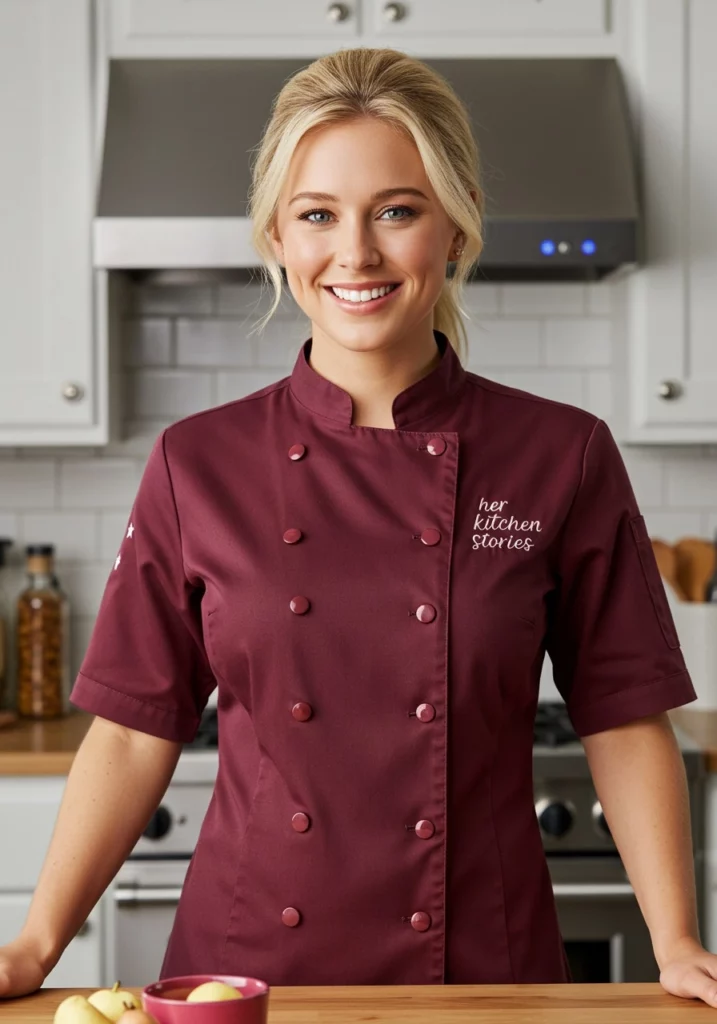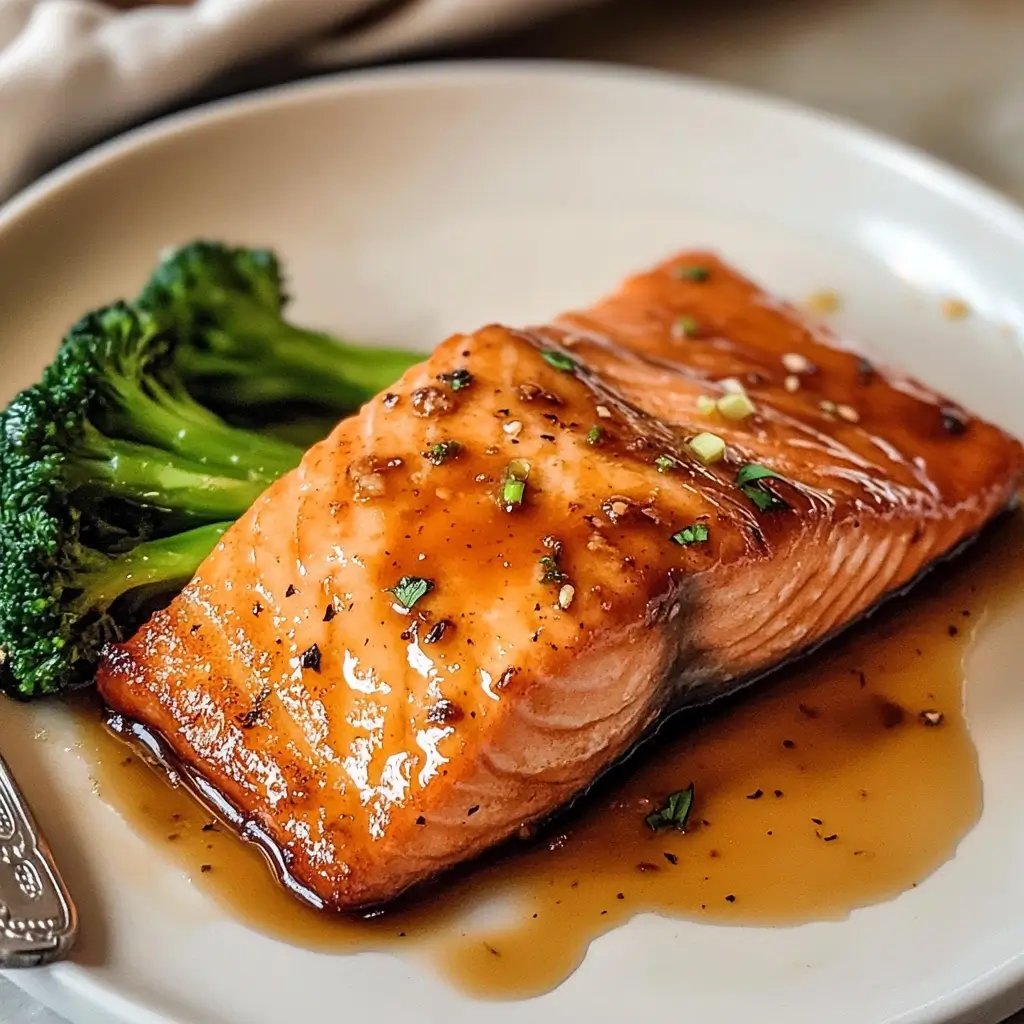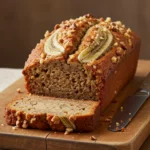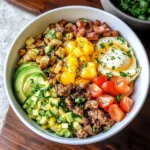In our house, weeknight dinners are often a race against the clock. Between school pickups, after-school activities, and the general hustle of daily life, finding time to cook something both healthy and delicious can feel like a Herculean task. That’s why recipes that are quick, easy, and absolutely packed with flavor are gold. This Maple Glazed Salmon recipe has become an absolute staple in our rotation, and for very good reason. From the first time I tried it, the combination of sweet maple syrup, savory soy sauce, and fragrant garlic coating flaky, tender salmon was a hit. Even my pickiest eater, who usually eyes fish with suspicion, devoured it! The best part? It truly lives up to its promise of being ready in under 20 minutes, making it a lifesaver on busy evenings. If you’re looking for a foolproof, flavorful, and fast way to get a healthy and satisfying meal on the table, look no further. This Maple Glazed Salmon is about to become your new go-to recipe too.
Ingredients for Irresistible Maple Glazed Salmon
This recipe keeps the ingredient list short and sweet, focusing on maximizing flavor with just a handful of pantry staples. Here’s what you’ll need to create this culinary magic:
- 4 Salmon Fillets: The star of the show! Aim for fillets that are roughly the same size and thickness for even cooking. Skin-on or skin-off is up to your preference; skin-on will result in crispier skin if you choose to broil it skin-side up, while skin-off is easier to eat for some. Fresh salmon is always wonderful if available, but frozen and thawed salmon works beautifully too, making this recipe accessible anytime.
- Pinch of Salt: A simple yet crucial ingredient! Salt enhances the natural flavors of the salmon and balances the sweetness of the maple glaze. We just need a pinch to season the fish directly before glazing.
- ¼ Cup Pure Maple Syrup: This is what gives the glaze its signature sweetness and that beautiful, glossy sheen. Make sure to use pure maple syrup, not pancake syrup, for the best flavor and authentic maple taste. The real deal is worth it!
- 2 Tablespoons Soy Sauce: Soy sauce brings a wonderful umami depth and savory saltiness that perfectly complements the sweetness of the maple syrup. It also helps to tenderize the salmon slightly and adds a beautiful color to the glaze. For a gluten-free option, you can use tamari or coconut aminos.
- 2 Garlic Cloves, Minced: Garlic adds a pungent, aromatic kick that elevates the glaze from simple to sensational. Freshly minced garlic is always best for maximum flavor, but in a pinch, pre-minced garlic can work.
- ½ Teaspoon Cornstarch: This seemingly small amount of cornstarch is the secret to transforming the marinade into a luscious, thickened glaze. It helps the sauce cling beautifully to the salmon during broiling, creating that irresistible sticky-sweet coating.
Step-by-Step Instructions for Perfect Maple Glazed Salmon
This recipe is designed to be incredibly straightforward, making it perfect for even novice cooks. Follow these simple steps to create perfectly cooked, deliciously glazed salmon every time:
- Prepare the Salmon (If Necessary): If you’re using frozen salmon, the very first step is to ensure it’s completely thawed. The best way to thaw salmon is in the refrigerator overnight. If you’re short on time, you can quick-thaw it by placing the sealed fillets in a zip-top bag and submerging them in a bowl of cold water. Change the water every 30 minutes until the salmon is thawed. Once thawed, gently pat the salmon fillets dry with paper towels. This is an important step as it helps the glaze adhere better and allows the salmon to brown slightly in the oven.
- Preheat Your Oven to 400°F (200°C): Get your oven preheating to 400°F (200°C). This temperature is ideal for baking salmon as it cooks it through quickly while keeping it moist and tender. Make sure your oven rack is positioned in the center for even heat distribution.
- Whisk Together the Maple Glaze: In a medium-sized bowl, combine the ¼ cup of pure maple syrup, 2 tablespoons of soy sauce, and 2 minced garlic cloves. Whisk these ingredients together until they are well combined. The maple syrup and soy sauce should emulsify slightly, creating a smooth and fragrant marinade. Set this bowl aside for now. This simple marinade is the flavor powerhouse of the dish.
- Prepare the Baking Sheet and Salmon: Line a baking sheet with aluminum foil. This makes cleanup a breeze! Place the salmon fillets on the foil-lined baking sheet, leaving a little space between each fillet for even cooking. Pat the top of each salmon fillet dry again with paper towels – this step, while seemingly minor, is key to achieving a nice sear or browning on the salmon. Sprinkle each fillet with a pinch of salt. Seasoning the salmon directly before glazing ensures that the flavor penetrates the fish itself, not just the glaze.
- First Glazing and Baking: Now for the flavor infusion! Using a pastry brush or spoon, brush half of the prepared maple glaze evenly over the tops and sides of the salmon fillets. Don’t use all the glaze at this point – we’ll use the rest to create the thickened glaze later. Place the baking sheet with the glazed salmon in the preheated oven and bake for 12 minutes. Baking at 400°F for 12 minutes is usually perfect for salmon fillets of average thickness (around 1-inch). The salmon should be mostly cooked through at this point but will still be tender.
- Prepare the Thickened Maple Glaze: While the salmon is baking, it’s time to transform the remaining marinade into a beautiful, glossy glaze. Pour the remaining half of the marinade into a small saucepan. Whisk in the ½ teaspoon of cornstarch. Make sure the cornstarch is fully dissolved into the liquid to prevent any lumps. Place the saucepan over medium-low heat on your stovetop. Stir the glaze mixture occasionally as it heats. Continue to cook and stir until the glaze thickens slightly and becomes glossy. This should take about 2-5 minutes. You’ll notice the glaze becoming more viscous and coating the back of a spoon. Be careful not to overheat or boil the glaze too vigorously, as it can become too thick or sticky.
- Broil for Caramelization and Final Glazing: After the salmon has baked for 12 minutes, carefully remove the baking sheet from the oven. Switch your oven setting to BROIL (high heat). Broiling adds a final touch of caramelization and beautiful color to the glaze. Brush the thickened maple glaze generously over the top of each salmon fillet. Return the baking sheet to the oven under the broiler. Broil for just 2-3 minutes, watching very closely to prevent burning. The glaze should become bubbly, caramelized, and deeply golden brown. The salmon should be cooked through and flake easily with a fork.
- Serve and Enjoy! Once the broiling is complete and the glaze looks perfectly caramelized, remove the baking sheet from the oven. Let the salmon rest for a minute or two before serving. This allows the juices to redistribute, resulting in even more tender and flavorful salmon. Garnish with fresh herbs like parsley or chives if desired, and serve immediately while it’s hot and delicious.
Nutrition Facts: A Healthy and Delicious Choice
Maple Glazed Salmon isn’t just delicious; it’s also a wonderfully nutritious meal. Here’s an estimated nutritional breakdown per serving (based on 4 servings and using typical salmon fillet sizes):
- Serving Size: 1 Salmon Fillet (approximately 4 oz cooked)
- Calories: Approximately 350-450 calories (This can vary depending on the fat content of the salmon and the exact amount of glaze used)
- Protein: 30-40 grams (Salmon is an excellent source of high-quality protein, essential for muscle building and repair, and overall bodily functions)
- Fat: 20-30 grams (Primarily healthy fats, including Omega-3 fatty acids, which are beneficial for heart health, brain function, and reducing inflammation)
- Saturated Fat: Varies depending on the type of salmon, but generally moderate.
- Omega-3 Fatty Acids: Salmon is rich in Omega-3s, particularly EPA and DHA, known for their numerous health benefits.
- Carbohydrates: 5-10 grams (Mainly from the maple syrup in the glaze. This is a relatively low-carbohydrate meal)
- Sodium: Varies depending on the soy sauce used. Using low-sodium soy sauce will significantly reduce the sodium content.
- Vitamins and Minerals: Salmon is packed with essential vitamins and minerals, including:
- Vitamin D: Important for bone health and immune function.
- Vitamin B12: Crucial for nerve function and red blood cell formation.
- Potassium: Important for blood pressure regulation.
- Selenium: An antioxidant that supports thyroid function and the immune system.
Important Note: These are estimates, and the exact nutritional content will vary depending on the specific ingredients used and the size of the salmon fillets. For precise nutritional information, you can use a nutrition calculator app or website and input the specific ingredients you use.
Preparation Time: Speedy Weeknight Dinner
One of the biggest appeals of this Maple Glazed Salmon recipe is its incredible speed. Here’s a breakdown of the time commitment:
- Prep Time: 5 minutes (This includes thawing salmon if needed, gathering ingredients, mincing garlic, and whisking together the glaze.)
- Cook Time: 15 minutes (12 minutes baking + 2-3 minutes broiling + glaze thickening time)
- Total Time: 20 minutes
From start to finish, you can have this flavorful and healthy salmon dish on the table in just 20 minutes! This makes it an absolute lifesaver for busy weeknights when time is of the essence. The minimal prep work and quick cooking time mean you can enjoy a restaurant-quality meal without spending hours in the kitchen.
How to Serve Your Delicious Maple Glazed Salmon
Maple Glazed Salmon is incredibly versatile and pairs well with a wide variety of side dishes. Here are some delicious serving suggestions to create a complete and satisfying meal:
- Grains:
- Rice: Steamed white rice, brown rice, or wild rice are all excellent choices. They soak up the extra maple glaze beautifully and provide a neutral base to complement the rich salmon flavor.
- Quinoa: A protein-packed and nutritious option. Quinoa has a slightly nutty flavor that pairs nicely with the sweet and savory glaze.
- Couscous: Light and fluffy couscous is a quick-cooking grain that’s perfect for weeknight dinners.
- Farro or Barley: For a heartier grain option, consider farro or barley, which offer a chewy texture and nutty flavor.
- Vegetables:
- Roasted Vegetables: Roasted broccoli, asparagus, Brussels sprouts, carrots, or bell peppers are all fantastic accompaniments. Roasting vegetables brings out their natural sweetness and creates a wonderful textural contrast with the tender salmon.
- Steamed Green Beans or Asparagus: For a quick and healthy side, steamed green beans or asparagus are simple and elegant.
- Sautéed Spinach or Kale: Garlic sautéed spinach or kale adds a boost of nutrients and a slightly bitter green element to balance the sweetness of the glaze.
- Salad: A fresh green salad with a light vinaigrette provides a refreshing contrast to the richness of the salmon. Consider a salad with mixed greens, cherry tomatoes, cucumbers, and a lemon vinaigrette.
- Potatoes:
- Mashed Potatoes: Creamy mashed potatoes are a classic comfort food side that pairs well with almost anything, including maple glazed salmon.
- Roasted Potatoes: Roasted potatoes, whether diced or wedges, are another delicious option. You can roast them alongside the salmon or prepare them separately.
- Sweet Potato Fries or Wedges: The sweetness of sweet potatoes complements the maple glaze beautifully.
- Bread:
- Crusty Bread: Serve with a side of crusty bread, like a baguette or sourdough, to soak up any extra glaze on your plate.
- Sauces and Garnishes:
- Fresh Herbs: Garnish with fresh parsley, chives, or dill for a pop of freshness and color.
- Lemon Wedges: A squeeze of fresh lemon juice brightens up the flavors of the salmon and glaze.
- Sesame Seeds: A sprinkle of sesame seeds adds a nutty flavor and textural element.
Serving Suggestions for Different Occasions:
- Weeknight Family Dinner: Serve with steamed rice and roasted broccoli for a quick, healthy, and satisfying meal.
- Casual Dinner Party: Pair with quinoa salad, roasted asparagus, and crusty bread for a slightly more elevated presentation.
- Romantic Dinner for Two: Serve with mashed sweet potatoes, sautéed spinach, and a glass of white wine for a cozy and delicious meal.
Additional Tips for Perfect Maple Glazed Salmon Every Time
While this recipe is incredibly easy, here are a few extra tips and tricks to ensure your Maple Glazed Salmon is always a success:
- Choose High-Quality Salmon: The quality of your salmon will significantly impact the final dish. Look for salmon fillets that are vibrant in color, firm to the touch, and have a fresh, clean smell. Fresh salmon is ideal when available, but frozen salmon can be just as good if it’s properly thawed and of good quality. Consider different types of salmon like Sockeye, King, or Coho – each has a slightly different flavor and fat content. For a richer flavor, opt for King or Sockeye; for a milder taste, Coho is a good choice.
- Don’t Overcook the Salmon: Salmon is best when cooked to just medium or medium-well. Overcooked salmon will be dry and tough. The flesh should be opaque and flake easily with a fork. A good rule of thumb is to cook salmon for about 4-6 minutes per half-inch of thickness. Use a food thermometer to ensure doneness if you’re unsure. Salmon is cooked through when it reaches an internal temperature of 145°F (63°C). However, salmon continues to cook slightly after being removed from the oven, so you can take it out when it reaches around 140°F (60°C) for perfectly moist results.
- Customize Your Glaze: While the basic maple-soy-garlic glaze is delicious on its own, feel free to experiment with flavor variations!
- Spice it up: Add a pinch of red pepper flakes or a dash of sriracha to the glaze for a touch of heat.
- Add Ginger: Grate a small piece of fresh ginger into the glaze for a warm, aromatic flavor.
- Citrus Zest: Lemon or orange zest adds brightness and freshness.
- Dijon Mustard: A teaspoon of Dijon mustard can add a tangy depth to the glaze.
- Sesame Oil: A teaspoon of sesame oil enhances the Asian-inspired flavors.
- Watch the Broiler Carefully: Broiling is a quick way to caramelize the glaze, but it can also quickly burn if you’re not attentive. Keep a close eye on the salmon while it’s under the broiler. It should only take 2-3 minutes to achieve that beautiful caramelized glaze. Position the oven rack so the salmon is not too close to the broiler element to prevent scorching.
- Adjust Cooking Time Based on Fillet Thickness: The recipe is based on average thickness salmon fillets (around 1 inch). If your fillets are thinner or thicker, you’ll need to adjust the baking time accordingly. Thinner fillets will cook faster, so reduce the baking time by a few minutes. Thicker fillets may need a few extra minutes in the oven. Always check for doneness to avoid overcooking or undercooking.
Frequently Asked Questions (FAQ) About Maple Glazed Salmon
Here are some common questions people ask about making Maple Glazed Salmon:
Q1: Can I use pancake syrup instead of pure maple syrup?
A: While pancake syrup might seem like a convenient substitute, it’s not recommended. Pancake syrup is typically made with high-fructose corn syrup and artificial flavors and lacks the complex, nuanced flavor of pure maple syrup. Pure maple syrup provides a richer, more authentic maple taste that is essential to the success of this glaze. For the best results, stick with pure maple syrup.
Q2: I don’t have soy sauce. What can I use instead?
A: If you don’t have soy sauce, you can use tamari or coconut aminos as substitutes. Tamari is a gluten-free soy sauce alternative with a similar savory flavor. Coconut aminos are also gluten-free and soy-free, with a slightly sweeter and less salty flavor than soy sauce. You might need to adjust the salt in the recipe if using coconut aminos. In a pinch, you could even use Worcestershire sauce, though it will have a different flavor profile.
Q3: Can I make the maple glaze ahead of time?
A: Yes, you can prepare the maple glaze ahead of time. Whisk together the maple syrup, soy sauce, and garlic, but do not add the cornstarch until you are ready to cook. Store the glaze mixture in an airtight container in the refrigerator for up to 2 days. When you’re ready to cook, whisk in the cornstarch and proceed with the recipe instructions. The thickened glaze is best made fresh right before broiling for optimal texture and shine.
Q4: How should I store leftover Maple Glazed Salmon?
A: Leftover Maple Glazed Salmon should be stored in an airtight container in the refrigerator. It will keep well for up to 3 days. To reheat, you can gently warm it in the oven at 300°F (150°C) or in the microwave. Be careful not to overheat it, as it can become dry. Cold Maple Glazed Salmon is also delicious flaked over salads or used in fish tacos.
Q5: Can I grill or pan-fry the Maple Glazed Salmon instead of baking?
A: Yes, you can definitely grill or pan-fry Maple Glazed Salmon!
- Grilling: Preheat your grill to medium heat. Place the salmon fillets on a sheet of foil or directly on the grill grates (oiled to prevent sticking). Brush with half the glaze and grill for 4-6 minutes per side, or until cooked through. Thicken the remaining glaze on the stovetop as directed and brush over the grilled salmon before serving.
- Pan-Frying: Heat a tablespoon of oil in a skillet over medium-high heat. Place the salmon fillets skin-side down (if using skin-on fillets) in the hot skillet. Sear for 3-4 minutes until the skin is crispy. Flip and cook for another 3-5 minutes, or until cooked through. Thicken the remaining glaze on the stovetop and brush over the pan-fried salmon before serving.
No matter how you choose to cook it, this Maple Glazed Salmon recipe is sure to become a family favorite. Enjoy!
Print
Maple Glazed Salmon Recipe
Ingredients
- 4 Salmon Fillets: The star of the show! Aim for fillets that are roughly the same size and thickness for even cooking. Skin-on or skin-off is up to your preference; skin-on will result in crispier skin if you choose to broil it skin-side up, while skin-off is easier to eat for some. Fresh salmon is always wonderful if available, but frozen and thawed salmon works beautifully too, making this recipe accessible anytime.
- Pinch of Salt: A simple yet crucial ingredient! Salt enhances the natural flavors of the salmon and balances the sweetness of the maple glaze. We just need a pinch to season the fish directly before glazing.
- ¼ Cup Pure Maple Syrup: This is what gives the glaze its signature sweetness and that beautiful, glossy sheen. Make sure to use pure maple syrup, not pancake syrup, for the best flavor and authentic maple taste. The real deal is worth it!
- 2 Tablespoons Soy Sauce: Soy sauce brings a wonderful umami depth and savory saltiness that perfectly complements the sweetness of the maple syrup. It also helps to tenderize the salmon slightly and adds a beautiful color to the glaze. For a gluten-free option, you can use tamari or coconut aminos.
- 2 Garlic Cloves, Minced: Garlic adds a pungent, aromatic kick that elevates the glaze from simple to sensational. Freshly minced garlic is always best for maximum flavor, but in a pinch, pre-minced garlic can work.
- ½ Teaspoon Cornstarch: This seemingly small amount of cornstarch is the secret to transforming the marinade into a luscious, thickened glaze. It helps the sauce cling beautifully to the salmon during broiling, creating that irresistible sticky-sweet coating.
Instructions
- Prepare the Salmon (If Necessary): If you’re using frozen salmon, the very first step is to ensure it’s completely thawed. The best way to thaw salmon is in the refrigerator overnight. If you’re short on time, you can quick-thaw it by placing the sealed fillets in a zip-top bag and submerging them in a bowl of cold water. Change the water every 30 minutes until the salmon is thawed. Once thawed, gently pat the salmon fillets dry with paper towels. This is an important step as it helps the glaze adhere better and allows the salmon to brown slightly in the oven.
- Preheat Your Oven to 400°F (200°C): Get your oven preheating to 400°F (200°C). This temperature is ideal for baking salmon as it cooks it through quickly while keeping it moist and tender. Make sure your oven rack is positioned in the center for even heat distribution.
- Whisk Together the Maple Glaze: In a medium-sized bowl, combine the ¼ cup of pure maple syrup, 2 tablespoons of soy sauce, and 2 minced garlic cloves. Whisk these ingredients together until they are well combined. The maple syrup and soy sauce should emulsify slightly, creating a smooth and fragrant marinade. Set this bowl aside for now. This simple marinade is the flavor powerhouse of the dish.
- Prepare the Baking Sheet and Salmon: Line a baking sheet with aluminum foil. This makes cleanup a breeze! Place the salmon fillets on the foil-lined baking sheet, leaving a little space between each fillet for even cooking. Pat the top of each salmon fillet dry again with paper towels – this step, while seemingly minor, is key to achieving a nice sear or browning on the salmon. Sprinkle each fillet with a pinch of salt. Seasoning the salmon directly before glazing ensures that the flavor penetrates the fish itself, not just the glaze.
- First Glazing and Baking: Now for the flavor infusion! Using a pastry brush or spoon, brush half of the prepared maple glaze evenly over the tops and sides of the salmon fillets. Don’t use all the glaze at this point – we’ll use the rest to create the thickened glaze later. Place the baking sheet with the glazed salmon in the preheated oven and bake for 12 minutes. Baking at 400°F for 12 minutes is usually perfect for salmon fillets of average thickness (around 1-inch). The salmon should be mostly cooked through at this point but will still be tender.
- Prepare the Thickened Maple Glaze: While the salmon is baking, it’s time to transform the remaining marinade into a beautiful, glossy glaze. Pour the remaining half of the marinade into a small saucepan. Whisk in the ½ teaspoon of cornstarch. Make sure the cornstarch is fully dissolved into the liquid to prevent any lumps. Place the saucepan over medium-low heat on your stovetop. Stir the glaze mixture occasionally as it heats. Continue to cook and stir until the glaze thickens slightly and becomes glossy. This should take about 2-5 minutes. You’ll notice the glaze becoming more viscous and coating the back of a spoon. Be careful not to overheat or boil the glaze too vigorously, as it can become too thick or sticky.
- Broil for Caramelization and Final Glazing: After the salmon has baked for 12 minutes, carefully remove the baking sheet from the oven. Switch your oven setting to BROIL (high heat). Broiling adds a final touch of caramelization and beautiful color to the glaze. Brush the thickened maple glaze generously over the top of each salmon fillet. Return the baking sheet to the oven under the broiler. Broil for just 2-3 minutes, watching very closely to prevent burning. The glaze should become bubbly, caramelized, and deeply golden brown. The salmon should be cooked through and flake easily with a fork.
- Serve and Enjoy! Once the broiling is complete and the glaze looks perfectly caramelized, remove the baking sheet from the oven. Let the salmon rest for a minute or two before serving. This allows the juices to redistribute, resulting in even more tender and flavorful salmon. Garnish with fresh herbs like parsley or chives if desired, and serve immediately while it’s hot and delicious.
Nutrition
- Serving Size: One Normal Portion
- Calories: 350-450
- Fat: 20-30 grams
- Carbohydrates: 5-10 grams
- Protein: 30-40 grams





